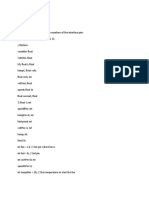Code
Uploaded by
Zunuran NasrullahCode
Uploaded by
Zunuran Nasrullah// Declare/assign Arduino IO-pins
const int temp_trans_pin = A0, Heater_pin = 13, FAN_pin = 6;
/*FAN_pin: here I used DC motor in stead of FAN because
I couldn't find the symbol for it. Similarly,for the
Heater (Heater_pin), I used LED.*/
// Set the range of the desired temperature
float MaxTemp = 25;/*Room temperature is [20,25] degree C */
// Include the LCD library code
#include <LiquidCrystal.h>
// Initialize the library with the numbers of the interface pins
LiquidCrystal LCD(12, 11, 5, 4, 3, 2);
float temp=0.0;
float procent=0.0;
int potency;
void setup() {
// System initialization
LCD.begin(16, 2);
pinMode(Heater_pin, OUTPUT);//LED in our case
// pinMode(FAN_pin, OUTPUT);
// Display the desired range of temperature
LCD.print("Room temp(C):");
LCD.setCursor(2,1);
//LCD.print(MinTemp); LCD.print("-");LCD.print(MaxTemp);
delay(2000);
}
void loop() {
float Eqv_volt, SensorTemp;
int analog_value = analogRead(A1);
temp = (analog_value * 5.0) / 1023.0;
procent = temp*20;
potency = map(analogRead(A2), 0, 1023, 0, 270);
Eqv_volt = analogRead(temp_trans_pin) * 5.0 / 1023;
SensorTemp = 100.0 * Eqv_volt-50.0;
// Display the sensor reading
/*Compare the sensor reading with the range of
acceptable temperatures*/
if(SensorTemp > MaxTemp){
digitalWrite(Heater_pin, LOW);
LCD.clear();
LCD.print("High T!");//higher than the max
LCD.setCursor(11,0);
LCD.print("Set T");
LCD.setCursor(13,1);
LCD.print("25");
Serial.print("v%");
Serial.println(temp);
LCD.setCursor(6, 0);
LCD.print("V% ");
LCD.setCursor(5, 1);
LCD.print(procent);
LCD.print("%");
delay(4000);
delay(4000);
}
else if(SensorTemp < MaxTemp){
LCD.clear();
LCD.print("Low T");//Less than the mini
LCD.setCursor(0, 1);
LCD.print("H On");
LCD.setCursor(11,0);
LCD.print("Set T");
LCD.setCursor(13,1);
LCD.print("25");
Serial.print("v%");
Serial.println(temp);
LCD.setCursor(6, 0);
LCD.print("V% ");
LCD.setCursor(5, 1);
LCD.print(procent);
LCD.print("%");
delay(4000);
//Turn the heater ON, LED in our case
digitalWrite(Heater_pin, HIGH);
delay(4000);
}
}
You might also like
- Question 2 (30 Marks) An Aluminium Tube Carrying A...No ratings yetQuestion 2 (30 Marks) An Aluminium Tube Carrying A...6 pages
- Example Testing Sketch For Various DHT HumidityNo ratings yetExample Testing Sketch For Various DHT Humidity4 pages
- Ungetesteter Arduino Coder Zur Steuerung Von Einem Kamin HeizungsoffenNo ratings yetUngetesteter Arduino Coder Zur Steuerung Von Einem Kamin Heizungsoffen4 pages
- Liquidcrystal: Int Int Int Int Int Int Int IntNo ratings yetLiquidcrystal: Int Int Int Int Int Int Int Int3 pages
- Arduino Colloidal Silver Controller UPDATENo ratings yetArduino Colloidal Silver Controller UPDATE8 pages
- Humidity & Temperature Sensor DHT22 With LCD (Arduino Uno R3 DIP)No ratings yetHumidity & Temperature Sensor DHT22 With LCD (Arduino Uno R3 DIP)2 pages
- Combined Turbidity & Temp Sensors With Esp 8266No ratings yetCombined Turbidity & Temp Sensors With Esp 82664 pages
- Digital Temperature Meter Using PIC16F688No ratings yetDigital Temperature Meter Using PIC16F6883 pages
- Temperature and Humidity sensor with LCD display.inoNo ratings yetTemperature and Humidity sensor with LCD display.ino2 pages
- Brauduino Semi Automated Single Vessel RIMSNo ratings yetBrauduino Semi Automated Single Vessel RIMS33 pages
- Setup Serial Serial Serial Serial Serial Serial: Void Begin Println Print Println Println PrintlnNo ratings yetSetup Serial Serial Serial Serial Serial Serial: Void Begin Println Print Println Println Println5 pages
- PID Control MAX6675 Thermocouple Arduino Schematic With Rotary Encoder100% (1)PID Control MAX6675 Thermocouple Arduino Schematic With Rotary Encoder13 pages
- m4 r5 o Level Iot Practical Classes Chapter 4 Diffrent Type of Sensors and ActuatorsNo ratings yetm4 r5 o Level Iot Practical Classes Chapter 4 Diffrent Type of Sensors and Actuators15 pages
- Incubadora Arduino - Sesor DHT22 and RelayNo ratings yetIncubadora Arduino - Sesor DHT22 and Relay3 pages
- Temperature and Humidity Sensor With LCD 1602 I2CNo ratings yetTemperature and Humidity Sensor With LCD 1602 I2C1 page
- Arduino Temperature and Humidity Sensor LCDNo ratings yetArduino Temperature and Humidity Sensor LCD2 pages
- Temperature and Humidity Sensing With LCD 1602 I2C DisplayNo ratings yetTemperature and Humidity Sensing With LCD 1602 I2C Display1 page
- EC1500 Refrigeration Trainer Datasheet 0719No ratings yetEC1500 Refrigeration Trainer Datasheet 07192 pages
- A Gas With A Molar Mass of 40 KG - Kmole and A Speci...No ratings yetA Gas With A Molar Mass of 40 KG - Kmole and A Speci...3 pages
- An Aluminium Tube Carrying A Hot Liquid at 112C Ha...No ratings yetAn Aluminium Tube Carrying A Hot Liquid at 112C Ha...5 pages

































































